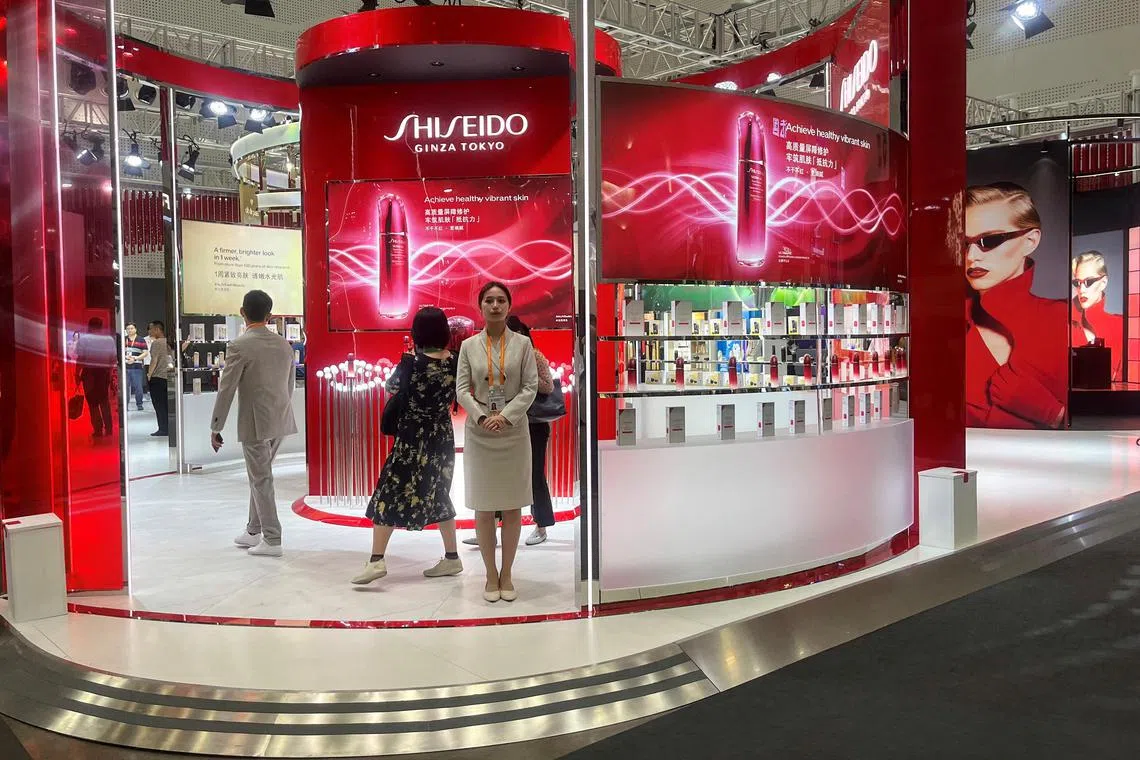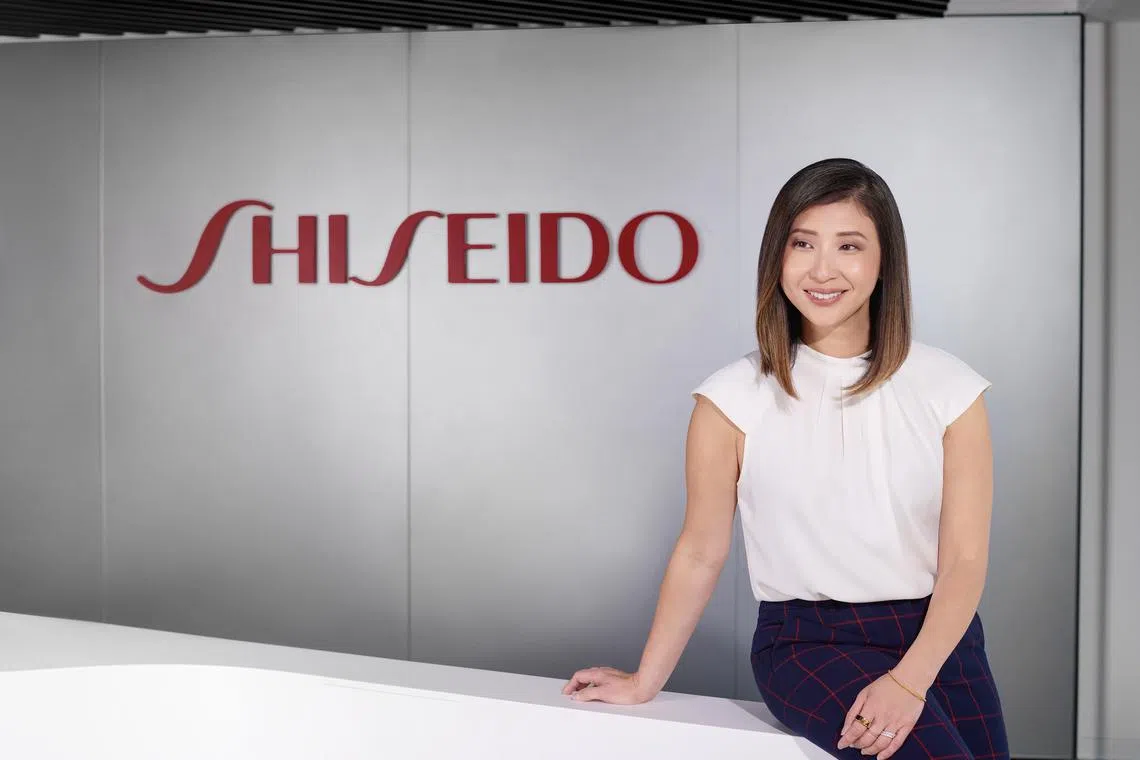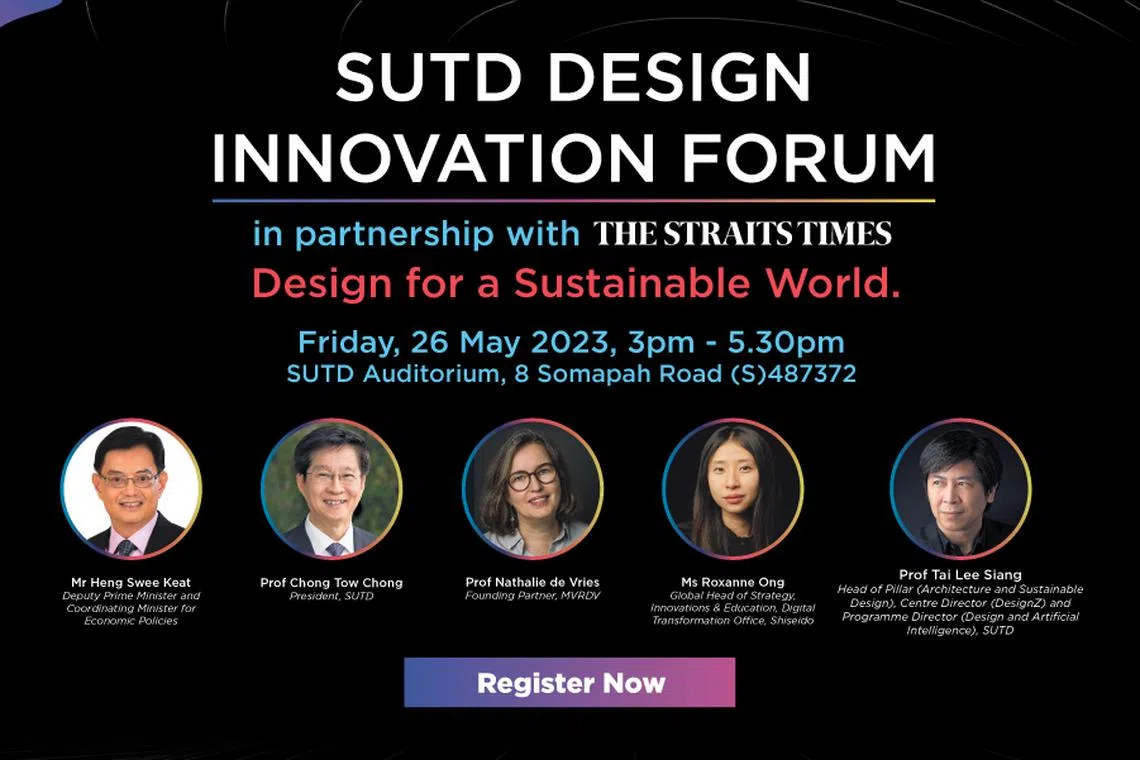How Shiseido is using tech to enrich lives, transform beauty business
Sign up now: Get ST's newsletters delivered to your inbox

The fifth Global Shiseido Digital Leadership Summit, held in April at the Global Innovation Center in Yokohama.
PHOTO: MITO SHIMPEI
Follow topic:
Japanese beauty brand Shiseido has embarked on an ambitious digital transformation drive to keep up to speed amid global crises and emerging technologies that have radically changed the beauty business.
Since the pandemic, beauty brands around the world have noted that while customers look for a real-world experience at the counter for make-up and skin creams, they are also interested in technology-powered tools such as virtual make-up try-ons before committing to shell out on a new lipstick or eye shadow ensemble.
With this in mind, Shiseido’s future-focused drive seeks to integrate beauty with technology such as data, artificial intelligence (AI) and Web 3.0 to better serve the changing behaviour of digitally savvy beauty consumers looking for a seamless, personalised and omnichannel experience, says Ms Roxanne Ong, senior vice-president of Strategy, Innovations and Education at the company’s Digital Transformation Office.
The office was set up in 2016 to accelerate the conversion to a digitally powered organisation. Three years later, the company articulated its data-driven vision of the beauty industry with a new mission statement: Beauty Innovations for a Better World.
Shiseido aims to grow its share of the global beauty industry, which is valued at more than US$500 billion (S$670 billion) a year by global management consultancy McKinsey and Company and features other entrenched names such as L’Oreal, Unilever and The Estee Lauder Companies Inc.
Post-pandemic, some of its recent cutting-edge digital engagement roll-outs include enhanced direct-to-consumer e-commerce sites with a range of online tools for greater customisation, virtual consultations with the brand’s beauty experts, and more targeted product matching.
Shiseido has tasked Ms Ong and her team “to look ahead and make sense of technology’s potential impact on human life, especially in the areas of beauty, health, wellness, consumption behaviour, and to formulate how Shiseido should respond”, she says.
Ms Ong, 47, who joined Shiseido in 2019, has nearly three decades of experience in digital technology, since her passion for it was sparked in university.
She has also worked at American beauty multinational The Estee Lauder Companies Inc, as well as at companies in a range of sectors such as hospitality and branding.
“For example, investing in one-on-one consultations through video channels was a no-brainer in 2019, as it allowed us then to democratise access to beauty knowledge for people who may be mobility-challenged or painfully shy of their skin conditions,” she says.
“After Covid-19 struck, it became a springboard for preparing our beauty consultants to shift their practice from behind the counter to getting in front of the camera to build their influence beyond dwindling retail traffic. It also prepares them for the future of work.”
The “future of work”, according to McKinsey, refers to perspectives essential for businesses to know and prepare for, which are centred on changes in the workplace driven by emerging technologies and other trends.
Shiseido, which celebrated its 150th anniversary in 2022, started as a Western-style pharmacy in Ginza, Tokyo, where its founder Arinobu Fukuhara paired science with beauty to spark innovation.
Selling novel beauty products since 1872 became ingrained in the DNA of the company after a slew of early products such as sanitary toothpaste and skin tonic flew off the shelves.
By 1917, it had introduced lead-free “rainbow” face powders in seven colours when traditional shops in the rest of the country were selling toxic white face powder popular with geishas, marking its foray into the lucrative cosmetics and skincare market.
And the rest is history.

Shiseido aims to grow its share of the global beauty industry, which is valued at more than $500 billion a year by McKinsey and Company.
PHOTO: REUTERS
Today, the multinational rakes in about US$8 billion annually and has offices in 120 countries, with more than 35,000 employees.
It is the fifth-largest beauty multinational in the world, having carved a niche in the global marketplace by blending Eastern approaches with Western scientific breakthroughs – and adding good design to seal the deal.
Technology combined with design thinking has been at the heart of how the company defines the beauty experience.
In design thinking, teams tackle problems based on a sound understanding of what motivates the end user to make a purchase.
“Design thinking, which prioritises the customer’s needs, is not new to us. The idea of ‘omotenashi’ which includes being selfless, empathetic and mindful in caring for guests, is also the ethos of Shiseido,” says Ms Ong, referring to the centuries-old practice of hospitality and mindfulness rooted in the traditional Japanese tea ceremony.
She says that a large part of the design thinking at Shiseido is to continuously seek to do better by leveraging technology, which then leads to driving change.
Embracing change has been a way of life for her.
“This is one aspect of my job that growing up in the 1980s and 1990s in Singapore has prepared me for,” says the Nanyang Girls’ High School alumna.
“With Singapore’s social and urban transformation as the backdrop in my formative years, and being exposed to my father’s business at an early age, tech-driven changes just became the norm for me.”
Her parents ran an apparel business serving fashion houses and department stores in the US and Europe.
From young, Ms Ong experienced first-hand how technology, from the telex printer to the fax machine and later to the Internet, could grow a business internationally.
In the mid-1990s, she went to Illinois in the US to study at Northwestern University (NU), with the aim of majoring in film-making.
One of the first classes she had to enrol in was Introduction To Digital Media, which piqued her interest in digital technology during the early days of the Internet.
“At NU, I had the benefit of a liberal arts education as well as exposure to a new love, digital technology, which set me up for a unique career path that intersects business, design and technology,” Ms Ong recounts.
She thinks that today’s education needs to adequately prepare students for the digital economy from as early as secondary school.
While looking to model in-house programmes for the Shiseido+ Digital Academy, she observed that the way the curriculum at the Singapore University of Technology and Design (SUTD) is structured combines critical thinking skills with technology and design, “while nurturing agility in students”.
“This is the blueprint for a future-forward education that will do better at producing empathetic, courageous and skilled visionaries and leaders. Our world needs more of that,” says Ms Ong.
In Tokyo, the company established the Shiseido+ Digital Academy in 2016 to close the digital literacy and skills gap for its staff and to help employees keep abreast of technological changes.
Ms Ong, who oversees its curriculum and operations as part of her Education remit, makes sure that its 10,000 students benefit from the data, technology and digital leadership programmes for employees to thrive in their careers.
“For instance, we are examining how our video platforms, digital skin diagnostic tools and AI can be integrated to alleviate pain points that our beauty consultants face so that they can focus on serving customers better.”
Although Shiseido was the first to introduce technological breakthroughs in beauty – such as skin diagnostic technology in 1981 that gave a laboratory-grade readout of a customer’s skin condition in department stores – being first-to-market is not enough.
“The real challenge is asking how we can do better than before,” says Ms Ong.
Last year, the brand unveiled a game-changing “shape-shifter” update of its hyaluronic acid product. Molecules of the serum enter the skin in a shrunken nano state before plumping it up below the surface to give the appearance of smoother, younger looking skin.
For Shiseido’s diagnostic skin tool, advancements in computing power, Internet connectivity, cloud computing and AI allowed the company to move the technology from department store counters right into customers’ smartphones.
This marks a turning point, says Ms Ong, as Shiseido’s research and development advances are also available to consumers no matter where they are.
The technology also empowers beauty consultants to help customers make informed, science-based decisions on the go.
Currently, Ms Ong’s team is studying emerging technologies that show promise.
These include augmented reality, an exciting frontier for the company which has already invested in virtual make-up try-ons, where shades of colour can be applied on an image of the customer’s face hygienically, without the need for hands-on sessions.
“We have also been exploring technologies such as blockchain and non-fungible tokens in the metaverse,” says Ms Ong, who chairs Shiseido’s web3/Metaverse Steering Council, which is tasked to prepare the company’s business to use Web3 and metaverse platforms thoughtfully.
These technologies which transcend borders hold great promise in humanising the digital beauty experience, she adds.
“The power of technology must enrich the people it touches, be they consumers or colleagues. Shiseido has lived by this philosophy since 1872, and this will never change.”
About Roxanne Ong

Singaporean Roxanne Ong graduated from Northwestern University in Illinois with a degree in Radio, Television and Film as well as Communication Studies and International Studies.
PHOTO: TEDDY MAKI
Ms Roxanne Ong is the senior vice-president of Strategy, Innovations and Education at Shiseido’s global Digital Transformation Office, and is based in Tokyo and New York.
Ms Ong, a Singaporean who graduated from Northwestern University in Illinois in the United States with a degree in radio, television and film as well as communication studies and international studies, has nearly 30 years’ experience in digital technology.
While at Northwestern, she took up electives in programming, 3D design and IT systems that enabled her to play the role of a “tech whisperer” in the business world. This also served as a foundation for her to acquire other key digital skills in programming, technology and design.
She has held global commercial and management roles at The Estee Lauder Companies Inc, W Hotels, St Regis Hotels, Ogilvy One, Hailo (now MyTaxi) and General Assembly.
From 2012 to 2015, Ms Ong won three Effie Awards, one of the highest accolades in the advertising industry, for her work at marketing communications agency Ogilvy One.
Ms Ong is also a passionate advocate of the idea that education in the 21st century must include digital and data, so all facets of society can have an equitable participation in shaping our technology-driven world. She is a frequent speaker on digitalisation and human-centred tech architecture at global thought leadership panels and summits.
SUTD Design Innovation Forum 2023

Register to attend the Design Innovation Forum by the Singapore University of Technology and Design (SUTD), in partnership with The Straits Times.
Registration is free and closes on May 21, 2023. Limited seats are available on a first-come, first-served basis.
When: Fri, May 26, 3pm to 5.30pm
Where: SUTD Auditorium, 8 Somapah Road, Singapore 487372
Keynote Speakers/Panellists:
Mr Heng Swee Keat, Deputy Prime Minister and Coordinating Minister for Economic Policies
Professor Chong Tow Chong, President of SUTD
Professor Nathalie de Vries, Founding Partner of MVRDV
Ms Roxanne Ong, Global Head of Strategy, Innovations & Education, Digital Transformation Office, Shiseido
Moderator: Professor Tai Lee Siang, Head of Pillar (Architecture and Sustainable Design), Centre Director (DesignZ) and Programme Director (Design and Artificial Intelligence), SUTD
To register and find out more, go to str.sg/SUTDforum23


